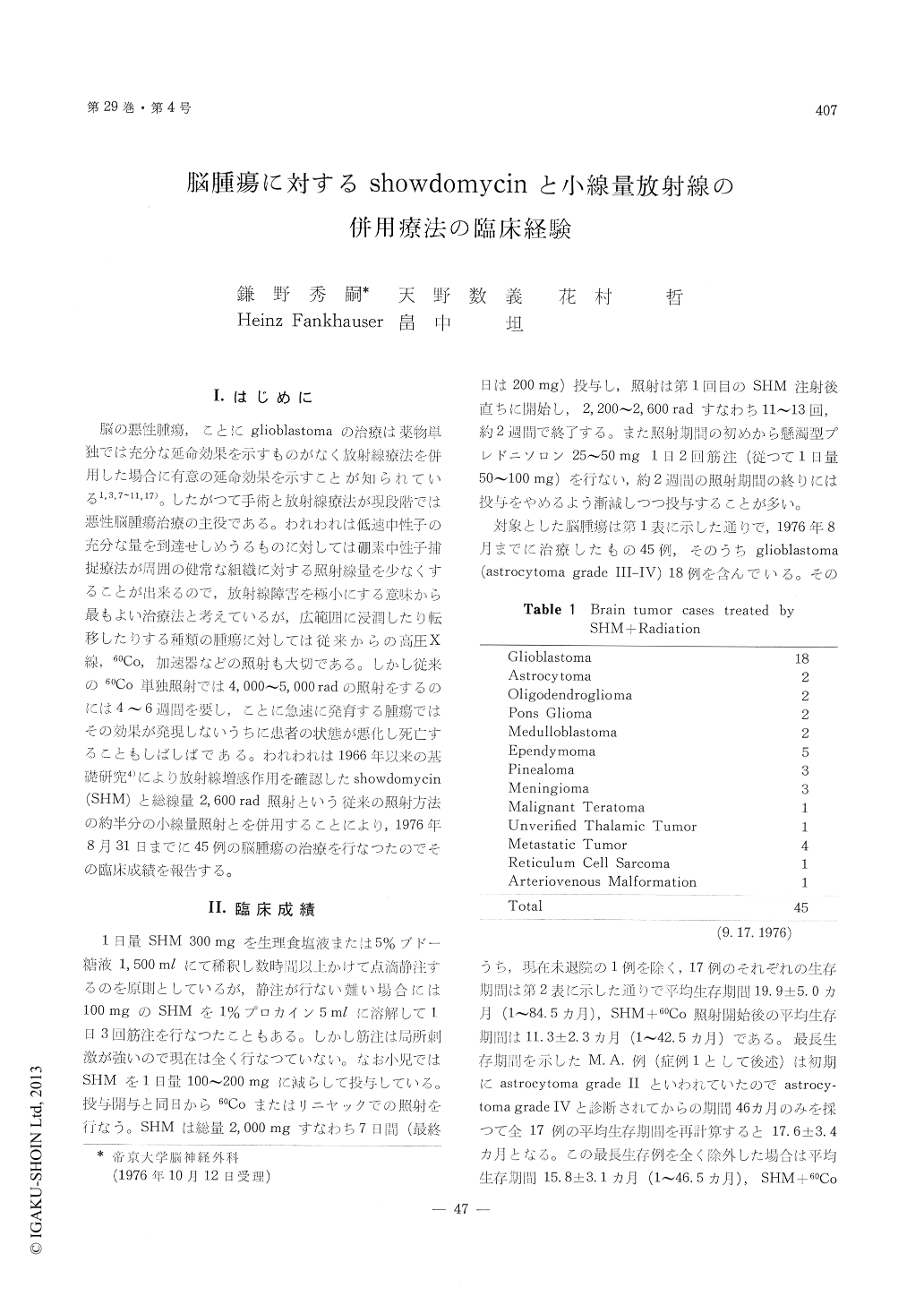Japanese
English
- 有料閲覧
- Abstract 文献概要
- 1ページ目 Look Inside
I.はじめに
脳の悪性腫瘍,ことにglioblastomaの治療は薬物単独では充分な延命効果を示すものがなく放射線療法を併用した場合に有意の延命効果を示すことが知られている1,3,7〜11,17)。したがつて手術と放射線療法が現段階では悪性脳腫瘍治療の主役である。われわれは低速中性子の充分な量を到達せしめうるものに対しては硼素中性子捕捉療法が周囲の健常な組織に対する照射線量を少なくすることが出来るので,放射線障害を極小にする意味から最もよい治療法と考えているが,広範囲に浸潤したり転移したりする種類の腫瘍に対しては従来からの高圧X線,60Co,加速器などの照射も大切である。しかし従来の60Co単独照射では4,000〜5,000 radの照射をするのには4〜6週間を要し,ことに急速に発育する腫瘍ではその効果が発現しないうちに患者の状態が悪化し死亡することもしばしばである。われわれは1966年以来の基礎研究4)により放射線増感作用を確認したshowdomycin(SHM)と総線量2,600 rad照射という従来の照射方法の約半分の小線量照射とを併用することにより,1976年8月31日までに45例の脳腫瘍の治療を行なつたのでその臨床成績を報告する。
Showdomycin is an antibiotic obtained from Streptomyces showdoensis in 1964 by Shionogi Research Labolatory, Japan. It has some anti-bacterial activity against Gram positive and negative bacterias. It is also noted to have antitumor activity against Ehrlich's ascites tumor and Hela cells to some extent. Its structure is 3-(β-D-ribofuranosyl) maleimide, a new class C-maleimide, having resemblance to N-ethylmaleimide. Its radio-sensitizing effect is suspected to be due to incor-poration of sulfhydryl radicals by Showdomycin.
Radiosensitizing effect of Showdomycin was experimentally demonstrated by three authors. Titani demonstrated radiosensitizing effect upon Escherichia Coli B/r by adding Showdomycin in culture media. Hatanaka et al. observed survival rate of mice, which were transplanted Ehrlich's ascites tumor pretreated with various doses ofradiation with or without concomitant medication. Showdomycin showed a most consistent radio-sensitizing effect compared with BUdR or 5-FU. Egawa et al. proved increased sensitivity of hair roots to radiation by adding Showdomycin.
Clinical trial on glioblastoma and other malignant brain tumors was done with the following regimen; 300 mg/day Showdomycin in 1500 ml physiological saline was administered by intravenous drip for 7 days. With either 60Co or Lineac 200 rad was given daily over a period of 2 weeks to give a total of 2,200-2,600 rad.
Fourty-five patients were treated by this method including 18 glioblastoma cases. Rapid improvement of neurological signs and symptoms was achieved usually within the first 2 weeks.
The mean survival of 17 glioblastoma patients (One case is excluded as post-treatment course is too short to evaluate) has reached 19.9±5.0 months after the first operation, and the mean survival after initiation of Showdomycin and radiation therapy is 11.0±2.8 months. It is excluded 4 patients with a history of previous radiation therapy, the average survival of 13 patients is 18.1±6.1 months. This result is comparable to survival data by several other authors of glioblastoma patients who treated with 4,000-6,000 rad conventional radiation therapy.

Copyright © 1977, Igaku-Shoin Ltd. All rights reserved.


